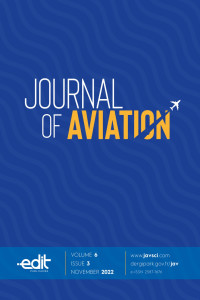Öz
Kaynakça
- Antwi, Elijah Kwabena, Kui Liu, and Hao Wang. 2018. “A Review on Ductile Mode Cutting of Brittle Materials.” Frontiers of Mechanical Engineering 13(2): 251–63.
- Chen, Shun Tong, and Kai Chieh Yang. 2022. Semi-Ductile Cutting Regime Technology for Machining Zerodur Glass-Ceramic Microstructures. Precision Engineering 74(2022): 92–109.
- Döhring, Thorsten et al. 2009. Heritage of ZERODUR® Glass Ceramic for Space Applications. Optical Materials and Structures Technologies IV 7425 (2009)
- Ecss. 2012. Space Engineering - Testing. Ecss-E-St-10-03C (2012): 1–128.
- Esmaeilzare, A., A. Rahimi, and S. M. Rezaei. 2014. Investigation of Subsurface Damages and Surface Roughness in Grinding Process of Zerodur ® Glass-Ceramic. Applied Surface Science 313: 67–75.
- Komanduri, R., D. A. Lucca, and Y. Tani. 1997. Technological Advances in Fine Abrasive Processes. CIRP Annals - Manufacturing Technology.
- Lawn, B. R., and M. V. Swain. 1975. Microfracture beneath Point Indentations in Brittle Solids. Journal of Materials Science 10(1): 113–22.
- Li, Kun, and T. Warren Liao. 1996. Surface/Subsurface Damage and the Fracture Strength of Ground Ceramics. Journal of Materials Processing Technology 57(3–4): 207–20.
- Sakai, Mototsugu. 2020. INDENTATION CONTACT Micro / Nano Physics of Materials. REVISED ED.
- Steele, William A et al. 2021. Subsurface Mechanical Damage Correlations after Grinding of Various Optical Materials. 58(9).
- Wang, Huadong et al. 2021. Evaluation of Subsurface Damage Layer of BK7 Glass via Cross-Sectional
- Surface Nanoindentation. Precision Engineering 67(October 2020): 293–300.
- Xavier Tonnellier. Precision Grinding for Rapid Manufacturing of Large Optics, PhD Thesis.
- Zhenqiang Yao, Weibin Gu, Kangmei Li. Relationship between Surface Roughness and Subsurface Crack Depth during Grinding of Optical Glass BK7.
Investigation of Characterization of Zerodur Glass Ceramics Used in Aerospace to Predict the Relationship between Surface Roughness and Subsurface Damage
Öz
Anahtar Kelimeler
Zerodur Surface Roughness Subsurface Damage Indentation Process Microhardness
Kaynakça
- Antwi, Elijah Kwabena, Kui Liu, and Hao Wang. 2018. “A Review on Ductile Mode Cutting of Brittle Materials.” Frontiers of Mechanical Engineering 13(2): 251–63.
- Chen, Shun Tong, and Kai Chieh Yang. 2022. Semi-Ductile Cutting Regime Technology for Machining Zerodur Glass-Ceramic Microstructures. Precision Engineering 74(2022): 92–109.
- Döhring, Thorsten et al. 2009. Heritage of ZERODUR® Glass Ceramic for Space Applications. Optical Materials and Structures Technologies IV 7425 (2009)
- Ecss. 2012. Space Engineering - Testing. Ecss-E-St-10-03C (2012): 1–128.
- Esmaeilzare, A., A. Rahimi, and S. M. Rezaei. 2014. Investigation of Subsurface Damages and Surface Roughness in Grinding Process of Zerodur ® Glass-Ceramic. Applied Surface Science 313: 67–75.
- Komanduri, R., D. A. Lucca, and Y. Tani. 1997. Technological Advances in Fine Abrasive Processes. CIRP Annals - Manufacturing Technology.
- Lawn, B. R., and M. V. Swain. 1975. Microfracture beneath Point Indentations in Brittle Solids. Journal of Materials Science 10(1): 113–22.
- Li, Kun, and T. Warren Liao. 1996. Surface/Subsurface Damage and the Fracture Strength of Ground Ceramics. Journal of Materials Processing Technology 57(3–4): 207–20.
- Sakai, Mototsugu. 2020. INDENTATION CONTACT Micro / Nano Physics of Materials. REVISED ED.
- Steele, William A et al. 2021. Subsurface Mechanical Damage Correlations after Grinding of Various Optical Materials. 58(9).
- Wang, Huadong et al. 2021. Evaluation of Subsurface Damage Layer of BK7 Glass via Cross-Sectional
- Surface Nanoindentation. Precision Engineering 67(October 2020): 293–300.
- Xavier Tonnellier. Precision Grinding for Rapid Manufacturing of Large Optics, PhD Thesis.
- Zhenqiang Yao, Weibin Gu, Kangmei Li. Relationship between Surface Roughness and Subsurface Crack Depth during Grinding of Optical Glass BK7.
Ayrıntılar
| Birincil Dil | İngilizce |
|---|---|
| Konular | Uzay Mühendisliği |
| Bölüm | Araştırma Makaleleri |
| Yazarlar | |
| Erken Görünüm Tarihi | 21 Kasım 2022 |
| Yayımlanma Tarihi | 22 Kasım 2022 |
| Gönderilme Tarihi | 18 Ağustos 2022 |
| Kabul Tarihi | 10 Eylül 2022 |
| Yayımlandığı Sayı | Yıl 2022 Cilt: 6 Sayı: 3 |
Journal of Aviation - JAV |
This journal is licenced under a Creative Commons Attiribution-NonCommerical 4.0 İnternational Licence


